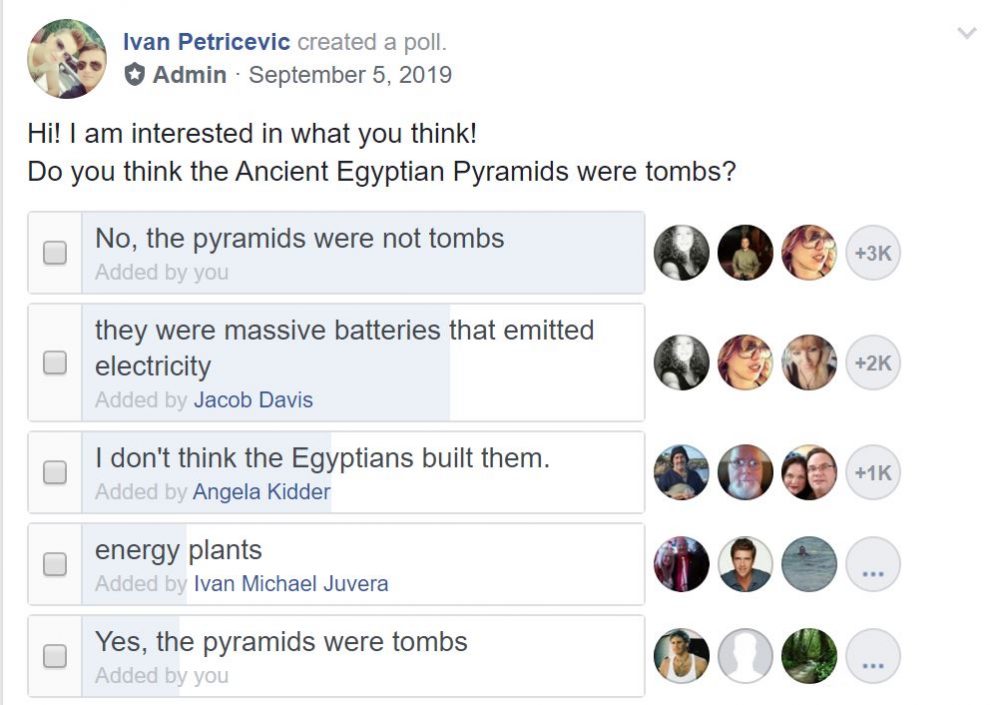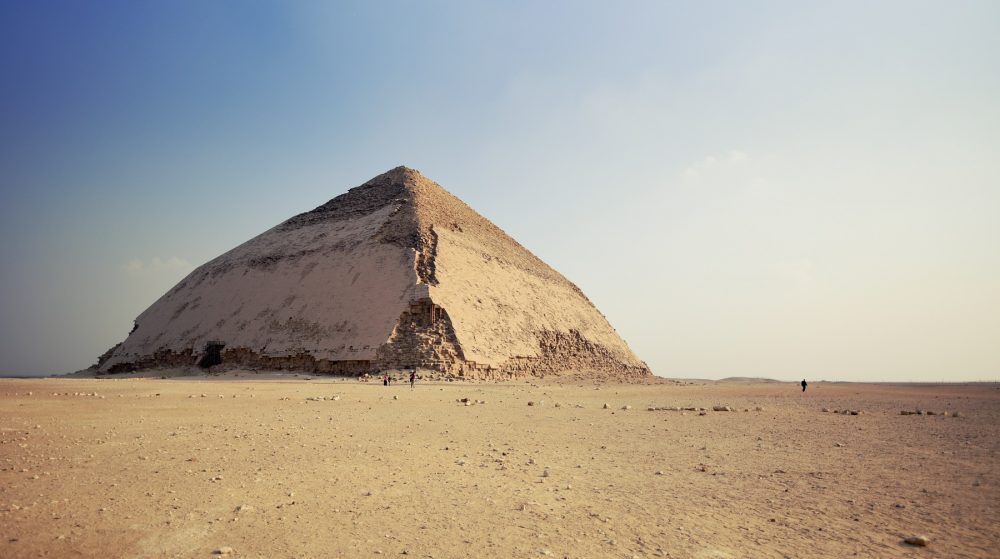Nearly 11,000 people participated in an internet poll asking whether or not the pyramids of Egypt were tombs. Less than 5 percent of the people that participated in the poll thought the pyramids were tombs.
In 2019, I decided to post a poll in a group I admin on Facebook called “ASOLK– Ancient School of Lost Knowledge” and ask people what they thought about the Egyptian pyramids and whether or not they were tombs. Egyptian pyramids–and pyramids in general–have always been my passion, and I wanted to see what people thought in the 21st century about the pyramids.
The results were surprising, with nearly eleven thousand people (10,981) participating in the poll.
This internet poll helped met an idea of what most people (at least on Facebook) thought about the purpose of the pyramids of Egypt and what people perceived these massive structures as in the 21st century.
The group has more than 106,000 members (as of January 2020) and is a place where people from all over the world post their ideas, theories, and discoveries about the ancient world.
The group was created to post anything related to subjects such as ancient civilizations, forgotten history, monuments, pyramids, and anything else that generally fits into that kind of history realm.
The question I posted was simple: “Do you think the Ancient Egyptian Pyramids were tombs?”.
I left the poll run from September 5th, 2019, to January 21st, 2020.
I created two possible answers and let the option for people to add their own. My answers were: No, the pyramids were not tombs, and yes, the Pyramids were tombs.
Surprising Results
3,072 people chose “no, the pyramids were not tombs,” while only 529 people, of the nearly 11,000 that participated in the poll, decide to pick “Yes, the pyramids were tombs.”
The second answer to the poll, created by one of the group’s users, was, “they were massive batteries that emitted electricity.” This was the second-most picked answer, with a total of 2,012 people believing the pyramids were not tombs but rather massive energy-emitting devices.
The third most chosen answer was, “I don’t think the Egyptians built them,” with 1,362 people picking that answer. Although it doesn’t really answer whether or not the users who chose the questions thought if the pyramids were tombs, it tells us that many people are convinced that the pyramids were there long before the Egyptian civilizations came to be.

The fourth most popular answer–also created by one of the groups’ users–was Energy Plants. Again, this answer tells us that 564 people believe that the pyramids were not tombs but rather technologically advanced devices built, perhaps not by the Ancient Egyptians.
The fifth most popular answer was, “yes, the pyramids were tombs.”
But many other user-generated questions were added to the possible answers in the poll.
Having 400 of fewer picks are answers such as “the pyramids are remnants of a much older and mysterious civilization, and were reused and refashioned by the ancient Egyptians,” and “They–the pyramids–were built with specific astronomy alignments using geometry.” People also added answers to the poll, such as “the Pyramids had an astronomical purpose,” and “the Pyramids were functional megaliths for resourcing, constructed in proper alignment to harness energies.”
Many other answers were added, and most of them seemed to agree that the pyramids were not tombs and that they were never meant to serve as such:
“Multipurpose megaliths designed to harness and equip the power of magnetic/vibrational/frequency energies for applications (i.e., healing).”
“Vibrational resonance creation chambers, for opening portals, covered in crystals to cater to these frequencies and intensify their power.”
The numbers speak for themselves. Of nearly 11,000 people that participated in a poll that ran from September 2019 to January 2020, only 529 believed to be pyramids were tombs of the kings of Egypt.
Here below is the screenshot of the poll and the top five answers.

This means that only 4.82% (529 people) who participated in the poll thought that the pyramids of Egypt were tombs, while a total of 95.18% people (10,452) in the group thought that the pyramids of Egypt were not tombs or had an answer that is indicative of the same.
- 529 is 4.82% of 10981
- 10452 is 95.18% of 10981
*Note: some people had the ability to choose more than one answer. However, only people who are members of the group could participate in the poll.
Egyptologists and Pyramids
Egyptologists have maintained for a long time that Egyptian pyramids were tombs and no more. Experts argue that the birth of the pyramids as a royal tomb can be traced back all the way to the third dynasty of Egypt and the reign of Pharaoh Djoser.
It is usually agreed upon among Egyptologists that Djoser commissioned the first pyramid designed, planned, and built by his royal vizier and architect Imhotep.
The Step Pyramid of Djoser is believed to have been built around 19 years, some 4,700 years ago. Although Egyptologists are convinced the Step pyramid served as a revolutionary new royal tomb, never has the mummified body of Djoser been recovered. When the pyramid was entered into in modern times, the so-called burial chamber was empty.
After Djoser, Egypt had to wait until the Fourth Dynasty reign of Sneferu for another pyramid to be built. This was the Pyramid at Meidum, a badly damaged pyramid that has undergone several redesigns in ancient times.
Sneferu also built two pyramids at Dahshur: The Bent Pyramid and the Red Pyramid. The Bent Pyramid is unique among more than 120 pyramids in Egypt. It has a unique shape and retains most of its outer limestone casing.

The Red Pyramid is seen as the first successful smooth-sided pyramid of Egypt. It is also the third-largest ever built and is the structure that many scholars say laid down the foundation for constructing the Great Pyramid of Giza.
Sneferu’s successor to the throne, Pharaoh Khufu, is believed to have commissioned the Great Pyramid of Giza early in his reign. The Great Pyramid is considered the most impressive pyramid ever constructed in Egypt. To build it, scholars calculate that construction workers used more than 2.3 million blocks of stone. The pyramid’s weight has been calculated at around 6.5 million tons.
Once completed, around 4,500 years ago, according to mainstream experts, the Great Pyramid of Giza remained the tallest man-made structure on the surface of the planet for more than 3,800 years.
Mainstem history tells us that after Khufu, Pharaoh Khafre became king and commissioned his pyramid, which nearly matched in size that of his predecessor Khufu. The smallest royal pyramid at Giza (not taking into consideration satellite pyramids) is the Pyramid of Menkaure, whose total volume (235,183 cubic meters (8,305,409 cu ft)) was less than the first pyramid in Egypt, the Step Pyramid of Djoser (330,400 cubic meters (11,667,966 cu ft)).
Join the discussion and participate in awesome giveaways in our mobile Telegram group. Join Curiosmos on Telegram Today. t.me/Curiosmos





